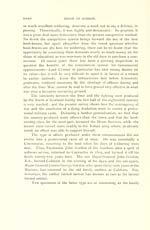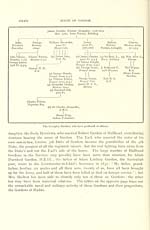New Spalding Club > House of Gordon > Gordons under arms
(43) Page xxxiii
Download files
Complete book:
Individual page:
Thumbnail gallery: Grid view | List view

THE MAKING OF THE MUSTER. XXXUl
which farmed Croughly, in the parish of Kirkmichael, as tenants of the
Dukes of Gordon, and which have given twenty-eight (Gordon) descendants
to the Services down to date. Like many other groups of professional
soldiers, the origin of the Croughly Gordons is " hard to be condescended
upon," as the Balbithan MS. would say. Their historian, Captain
George Huntly Blair Gordon, R.E., made an attempt in the Croughly
Book (1895) to trace them to the first Gordons of Cluny. But the solid
ground of descent begins only with John Gordon (died 1738), who
married Margaret, daughter of James Grant, of Ruthven. His son
James, born 1726, went over the hills to Strathdon for a bride (1760) in
the person of Anne, daughter of John Forbes, of Bellabeg. Thus it is
not difficult to understand how James's six sons, with the Gordon-Grant-
Forbes blood in their veins, all entered the military service of their
country between the years 1781-1804 as follows : —
1781 George (aged 16) . . . Bombay Army.
1782 John (aged ig) . . • Northern Fencibles.
1793 William Alexander (aged 24) Northern Fencibles.
1797 Robert (aged 17) . . • Aberdeenshire Militia.
1800 Charles (aged iS) . . . Madras Army.
1S04 James (aged 28) . . . Gordon Highlanders.
Robert duly returned to farm Croughly and was followed by his
only son John, who gave it up in 1843 ; two of the brothers had no
issue ; the other three became the ancestors of a regular military caste,
which has done its day's " darg " in many parts of our Dominions.
Thoughthey have not been connected with the old homestead for nearly
seventv years, they are still recalled in the beautiful kirkyard of Kirk-
michael by their moss-grown memorials, which form a little epitome of
the great task of building up the Empire rarely equalled in similar
circumstances. The Croughly Gordons, however, are only one of many
military groups in the same region ; we have the Gordons in Minmore
and Laggan, and Colonel George Gordon, of Glentromie, who gave five
of his own sons to the Army.
While the ducal line (which contributed of itself a great many
officers to both Services) was the greatest patron of soldiering, the
noble family of Aberdeen, which belong to a different line, produced
a large number of officers, though they were responsible for raising only
one regiment, the Sist. William, 2nd Earl of Aberdeen, who died in
1745, had ninety-four Gordon descendants in the Navy and Army, his
which farmed Croughly, in the parish of Kirkmichael, as tenants of the
Dukes of Gordon, and which have given twenty-eight (Gordon) descendants
to the Services down to date. Like many other groups of professional
soldiers, the origin of the Croughly Gordons is " hard to be condescended
upon," as the Balbithan MS. would say. Their historian, Captain
George Huntly Blair Gordon, R.E., made an attempt in the Croughly
Book (1895) to trace them to the first Gordons of Cluny. But the solid
ground of descent begins only with John Gordon (died 1738), who
married Margaret, daughter of James Grant, of Ruthven. His son
James, born 1726, went over the hills to Strathdon for a bride (1760) in
the person of Anne, daughter of John Forbes, of Bellabeg. Thus it is
not difficult to understand how James's six sons, with the Gordon-Grant-
Forbes blood in their veins, all entered the military service of their
country between the years 1781-1804 as follows : —
1781 George (aged 16) . . . Bombay Army.
1782 John (aged ig) . . • Northern Fencibles.
1793 William Alexander (aged 24) Northern Fencibles.
1797 Robert (aged 17) . . • Aberdeenshire Militia.
1800 Charles (aged iS) . . . Madras Army.
1S04 James (aged 28) . . . Gordon Highlanders.
Robert duly returned to farm Croughly and was followed by his
only son John, who gave it up in 1843 ; two of the brothers had no
issue ; the other three became the ancestors of a regular military caste,
which has done its day's " darg " in many parts of our Dominions.
Thoughthey have not been connected with the old homestead for nearly
seventv years, they are still recalled in the beautiful kirkyard of Kirk-
michael by their moss-grown memorials, which form a little epitome of
the great task of building up the Empire rarely equalled in similar
circumstances. The Croughly Gordons, however, are only one of many
military groups in the same region ; we have the Gordons in Minmore
and Laggan, and Colonel George Gordon, of Glentromie, who gave five
of his own sons to the Army.
While the ducal line (which contributed of itself a great many
officers to both Services) was the greatest patron of soldiering, the
noble family of Aberdeen, which belong to a different line, produced
a large number of officers, though they were responsible for raising only
one regiment, the Sist. William, 2nd Earl of Aberdeen, who died in
1745, had ninety-four Gordon descendants in the Navy and Army, his
Set display mode to: Large image | Transcription
Images and transcriptions on this page, including medium image downloads, may be used under the Creative Commons Attribution 4.0 International Licence unless otherwise stated. ![]()
| Publications by Scottish clubs > New Spalding Club > House of Gordon > Gordons under arms > (43) Page xxxiii |
|---|
| Permanent URL | https://digital.nls.uk/79781213 |
|---|
| Description | Volumes 47-53 are uniform with but not part of the club's series. |
|---|---|

